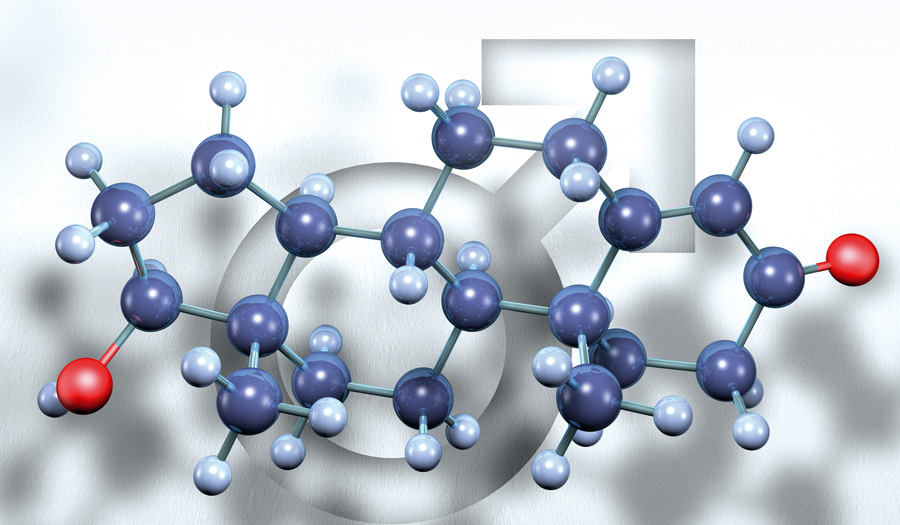 View / Download pdf version of this article
View / Download pdf version of this article
Although testosterone levels in males decline with age, the risks and benefits of testosterone supplementation in this
age group are unclear.
Older males may present with signs and symptoms suggestive of hypogonadism; some of these are less specific, such as
decreased energy or depressed mood, and others more specific, such as decreased or absent morning or spontaneous erections,
reduced libido and erectile dysfunction.1
The first step is to consider medical conditions or other factors which could be managed to improve signs and symptoms.
A number of medical conditions can influence the function of the HPG axis and are associated with hypogonadism,
including:2–4
- Type 2 diabetes
- End-stage renal disease
- Osteoporosis
- Moderate to severe COPD
- Severe obstructive sleep apnoea
- Pituitary tumour
- HIV
- Testicular cancer
- Haemochromatosis
- Chronic inflammatory disease, e.g. arthritis
- Eating disorders (malnutrition)
Lifestyle factors which decrease testosterone levels, include obesity, chronic excess alcohol intake, stress,
sleep deprivation, vigorous exercise and illicit drug use.
Medicines that interfere with the HPG axis include opioids, high dose systemic corticosteroids, chemotherapy
medicines and phenothiazines.
Biochemical investigation of hypogonadism may be appropriate for patients with symptoms which are adversely
affecting their quality of life. The recommended investigation is as follows:3
- Request an early morning serum total testosterone level
- If the level is below the reference range, repeat the test as 30% of males with an initially low testosterone level
have normal levels on re-testing
- A luteinizing hormone (LH) test can be ordered with the repeat testosterone level to help distinguish between primary
and secondary hypogonadism, if the total testosterone level is confirmed as being consistently low
- Measures of sex hormone binding globulin (SHBG) and free testosterone are only necessary if there is reason to suspect
that SHBG levels are abnormal, such as patients with marked obesity, thyroid disease or who are taking particular
medicines such as anticonvulsants
For males with consistent signs and symptoms and biochemical evidence of hypogonadism, it is recommended
that the decision of whether to initiate testosterone is discussed with an endocrinologist; only one formulation of testosterone
can be prescribed without endorsement from an endocrinologist. Testosterone replacement is more likely to be worthwhile
for those with specific symptoms for which improvements can be evaluated.
Testosterone treatment is contraindicated in males with prostate or breast cancer, primary liver tumours,
hypercalcaemia and nephritic syndrome.1, 5 Further investigations which should be conducted before initiation
include full blood count, PSA level and digital rectal examination. Testosterone treatment is not recommended in males
with a palpable prostate nodule or induration, with PSA level > 4.0 ng/ml (or 3.0 ng/ml if there is a family history
of prostate cancer), elevated haematocrit (PCV > 50%), or in patients with severe untreated obstructive sleep apnoea
or poorly controlled congestive heart failure.1
Prior to the initiation of testosterone, patients should be informed that the benefits and risks of treatment are to
some extent both uncertain as detailed data on long-term health outcomes in large randomised controlled trials is currently
lacking. In addition, patients should be made aware of the ongoing testing requirements during treatment to assess response
and safety (e.g. haematocrit, PSA and testosterone levels).
 For further information, see: “Prescribing
testosterone in ageing males: why you shouldn’t read this article”, BPJ 69
(Aug 2015).
For further information, see: “Prescribing
testosterone in ageing males: why you shouldn’t read this article”, BPJ 69
(Aug 2015).
 “Research Update: Testosterone use and
cardiovascular risk in older males”, BPJ 70 (Sept 2015).
“Research Update: Testosterone use and
cardiovascular risk in older males”, BPJ 70 (Sept 2015).
References
- Bhasin S, Cunningham GR, Hayes FJ, et al. Testosterone therapy in men with androgen deficiency syndromes: an Endocrine
Society clinical practice guideline. J Clin Endocrinol Metab 2010;95:2536–59. http://dx.doi.org/10.1210/jc.2009-2354
- Perry-Keene D. Low testosterone in men. Aust Prescr 2014;37:196–200.
- SonicEdu, Kyle C (Ed).Sonic Pathology handbook. Available from: www.snp.com.au (Accessed
Dec, 2015).
- Dohle GR, Arver S, Bettocchi C, et al. Guidelines on male hypogonadism. European Association of Urology, 2015. Available
from: http://uroweb.org/guideline/male-hypogonadism/ (Accessed
Dec, 2015).
- New Zealand Formulary (NZF). NZF v42. 2015. Available from: www.nzf.org.nz (Accessed
Dec, 2015).